
SITE ZERO
LEAD GAME & LEVEL DESIGN
PRODUCTION
1v1 Arena Looter Shooter
Unreal Engine 5.5
Trello
8 weeks
Group Project (10)
_95opa_DarkerBlue(1).png)
ABOUT THE GAME
MAIN FEATURES
-
Delivers tight, skill-based competition with responsive FPS combat and layered systems that reward mastery and bold decision-making
-
Players engage in short, intense rounds as enhanced operatives where every move counts and every shot could be the last
-
Focuses on adaptability and tactical precision with a deep player movement system
-
Collectibles dropped mainly by enemy AI are used to unlock and upgrade weapons during the match, forcing players to make strategic decisions on the fly
-
Round-based resets keep rounds fair and fresh, ensuring no long-term advantages
-
Skilled players can outmaneuver and outthink opponents through creativity and quick reflexes
Full Playthrough
MY KEY CONTRIBUTIONS
Click on the name of a section to jump there!
SOLE GAME & LEVEL DESIGNER - LEAD DESIGNER - kept design vision aligned across the team
CORE SYSTEMS & GAME-LOOP DESIGN
-
Designing Weapon System, Upgrade System & Economy System
-
Designing & creating Gameloops & Tutorial
-
Building the levels from whitebox to finish
-
Continuously iterating on the Level Design throughout the project for both the Main Level & Tutorial
-
Creating and updating Two-Pager, GDD & other Documentation
-
Making flowcharts & prototypes for core gameloops, weapon system, economy & AI
-
Balancing the values of Player health, movement systems, values for Weapons, Upgrades, AIs & Resources
-
Implementing & mixing a lot of the sounds. Creating and adding Reverb & Attenuation
-
Managing Trello, proposing sprint backlog & priorities. Leading playtests, many meetings & group discussions
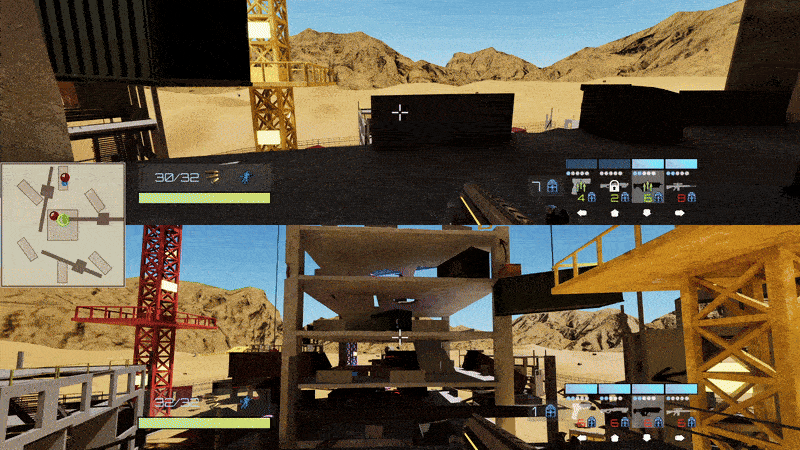


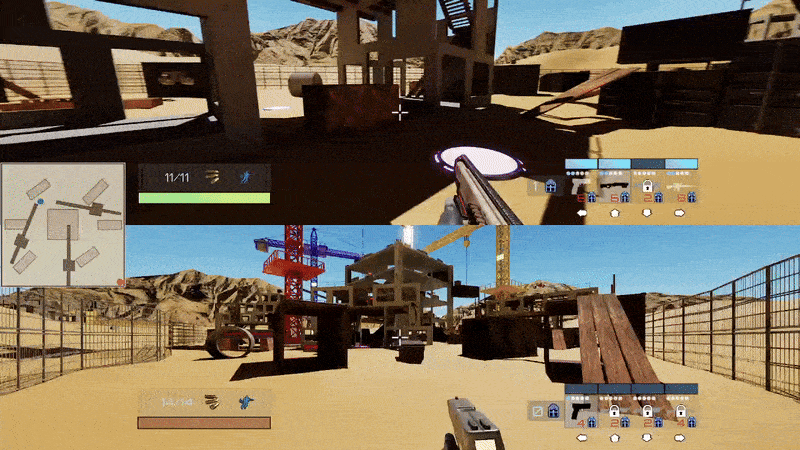

DESIGN CHALLENGES
KEEPING ROUNDS FAST-PACED
-
Goal: Supporting multiple playstyles (farming drones, aggressive pushes, or hybrid) while preventing matches from stalling if both players played defensively.
-
Solution: The level layout and drone spawns are tuned to funnel players toward the center, creating natural conflict points. Originally planned as a central boss enemy, scope cuts led to a mid-round lootbox that rewarded valuable pick-ups and halted drone spawns, accelerating the round. Weapons are upgraded mid-match while health stays static, naturally decreasing time-to-kill and pushing rounds to a conclusion without a shrinking zone.
-
Takeaway: Pacing can be set with multiple overlapping systems, not only with a single mechanic.
MAKING WEAPONS FEEL UNIQUE & FAIR
-
Goal: With a small arsenal, each weapon needs to feel distinct and satisfying while staying balanced in a competitive setting.
-
Solution: I gave weapons unique secondary abilities to reinforce identity. This makes balancing trickier, so I iterated through prototypes, adjusted power/cooldowns, and refined how abilities interacted with movement. Spreadsheets help as a baseline, but consistent playtesting and feedback are key to fine-tuning.
-
Takeaway: Balance requires more than analyzing numbers, even if it's a good foundation. Real player experience reveals what feels fair, fun, and strategically viable.
FINDING THE RIGHT MOVEMENT SYSTEM
-
Goal: Create a layered movement system that feels expressive without overwhelming players.
-
Solution: A grappling hook was prototyped but proved clunky during combat. Switching to jump pads offered quick, fluid repositioning and kept focus on combat. I experimented with cooldowns, stamina costs, and the feel of chaining movement abilities together to balance freedom, clarity, and overall gameplay.
-
Takeaway: Movement must serve flow and combat feel. Even a promising and cool mechanic can fail if it interrupts the player’s rhythm.
INTEGRATING AI-ENEMIES INTO A 1v1 SHOOTER
-
Goal: Use AI to add tension, variety, and a unique resource layer without overshadowing core PvP-combat.
-
Solution: Drones drop resources and healing, creating a risk vs. reward dynamic. Aggressive drones in the center are more valuable but harder to take down and placed in highly contested areas, while passive drones on the edges remain inactive until damaged, making them safer to farm but offering fewer rewards. Warning indicators (audio + visuals) give players a chance to react, keeping the focus on PvP.
-
Takeaway: AI-enemies can be more than just enemies; they can drive pacing, guide player movement, and create dynamic opportunities while still feeling fun and fair to fight.
Core Systems & Game-Loop Design
As the sole Game Designer on Site Zero, my primary goal was to create a dynamic, reactive gameplay loop that makes players constantly have to make meaningful decisions.
As mentioned previously, one of the core challenges was to avoid static or predictable matches. Unlike traditional shooters with fixed loadouts, rounds start with only a pistol, and players must scavenge Batteries from AI Drones and a central Lootbox to unlock and upgrade weapons in real time.
This approach balances combat, resource management, and risk versus reward, ensuring that matches escalate naturally without relying on artificial mechanics like shrinking zones.
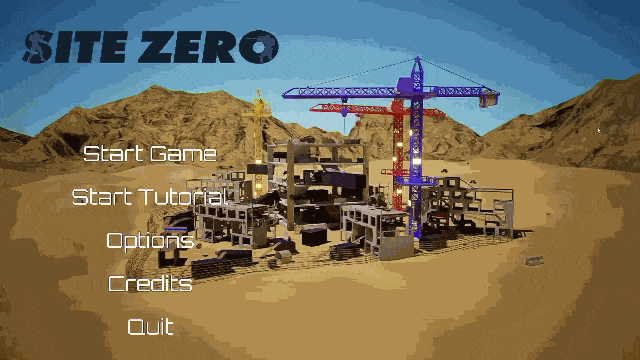
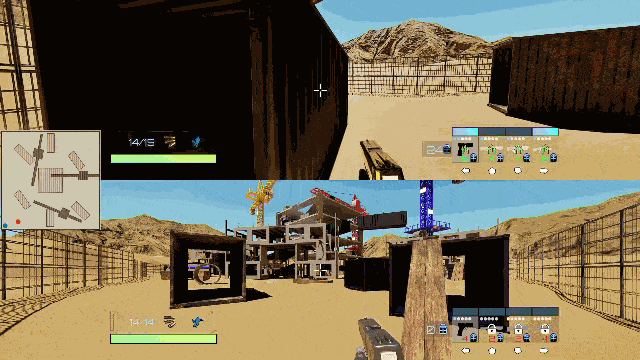
Building on this core loop, a key goal for the weapons was to make each feel unique and strategically meaningful.
Working closely with the Weapon System programmer, I designed weapons with distinct roles and abilities: the pistol encourages early resource farming and unlocks a temporary wall-hack ability, the assault rifle rewards precise aim with an aimable missile, the shotgun provides close-range utility and a versatile pulse-grenade ability, finally the sniper rifle serves as a high-risk, high-reward tool for skilled players.
Each ability introduces tactical choices, reinforcing the gameplay loop and encouraging players to adapt their strategy and gameplay on the fly.


Referring back to the economy loop built around resource scarcity and reward-driven decision-making, my goal for the AI and resources was to create meaningful risk-versus-reward scenarios that drive engagement.
Tier 1 Drones on the edges are safer but yield smaller rewards, while Tier 2 Drones and the central Lootbox are more contested and offer higher-value resources. Drones also drop healing pick-ups, integrating health management into the same decision-making loop.
AI behavior is tuned to this goal: passive Drones remain stationary until provoked, while aggressive Drones actively target players, naturally funneling them toward combat without overshadowing the PvP focus.


Finally, as mentioned previously, one of my design goals was to ensure players could understand and engage with all core systems quickly. The tutorial system introduces mechanics step by step, tracking actions like movement, combat, resource collection, and weapon abilities. Players progress only after completing each task, ensuring comprehension without overwhelming them. Mirrored paths allow both players to learn simultaneously before converging in a final 1v1 encounter, giving them a chance to immediately apply the systems in a controlled combat scenario.
Level Design
BUILDING THE CORE LAYOUT
As the sole Level Designer, I created both the main map and the tutorial level. For the main map, I began with a whitebox focused on gameplay clarity, verticality, and movement flow.
Early iterations were too cluttered, with objects breaking up combat arenas and making sightlines hard to read. Later revisions simplified the layout, reinforcing defined engagement zones and decision points that let players understand where fights were most likely to occur while still allowing room for creative movement.
The map is designed to be largely mirrored for fairness, but with subtle asymmetries. Crane positions and rotations (as explored earlier in the crane prototyping) give the blue and red sides slightly different flanking options and high-ground routes. This means that while both players have equal opportunities, they need to adapt positioning and timing depending on their side.
SHAPING COMBAT ENCOUNTERS
A key goal was to make combat “make sense” across the entire map. Every section is designed to reward smart positioning, situational awareness, and timing, ensuring that players have to carefully evaluate where to fight rather than relying solely on weapon choice.
For example, the sides of the central building feature longer sightlines. This makes rotating towards the middle more dangerous, but also creates natural hotspots for combat. By contrast, tighter areas closer to spawn support more aggressive flanks and surprise plays.
The balance of open and contained spaces keeps pacing dynamic, ensuring that encounters can unfold in multiple ways without stalling out.


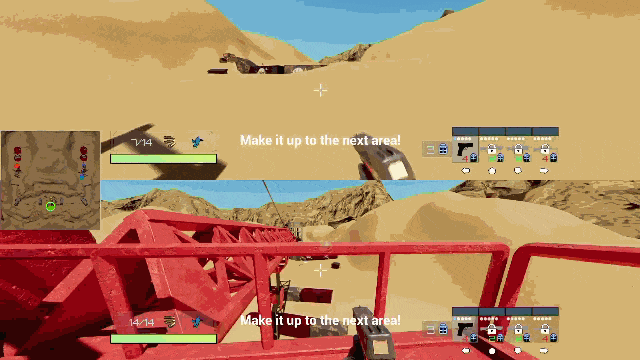

TUTORIAL LEVEL
The tutorial map uses two mirrored paths, allowing both players to progress at their own pace without pressure. Each segment is deliberately structured to teach one mechanic at a time, reinforced through sightline control, obstacle placement, and contained encounters that naturally guide learning. This approach reduces cognitive load and ensures that core systems are absorbed step by step.
At the end, both paths converge into a small 1v1 arena. This arena acts as a soft introduction to the competitive feel of the main map, letting players immediately apply what they have just learned in a safe but engaging duel, bridging the gap into the main map’s more complex flow.
GDD, Flowcharts & Prototyping
Right from the start of the Site Zero project,
I focused on setting a strong design foundation by creating documents such as the Script, Two-Pager and a full Game Design Document (GDD). These documents clearly outlined the project’s vision, gameplay systems, and development goals. I did my best to keep them updated throughout the process to ensure they accurately reflected design changes and ongoing iteration.


To make complex systems easier to understand and keep the team on the same page, I created flowcharts for the game loop, weapon upgrade system, AI behaviour, and economy systems. These helped align the team during standups and planning sessions, especially when discussing interdependent systems.
I also prototyped the crane rotation system to introduce dynamic cover, movable objects, and shifting lines of sight, enhancing tactical depth without being core to the gameplay loop. I explored several ways for players to interact with the system, including buttons and pressure plates, but ultimately found that allowing players to shoot panels was the most engaging and least intrusive method. This approach felt fast, responsive, and aligned naturally with the game’s overall movement and combat systems.
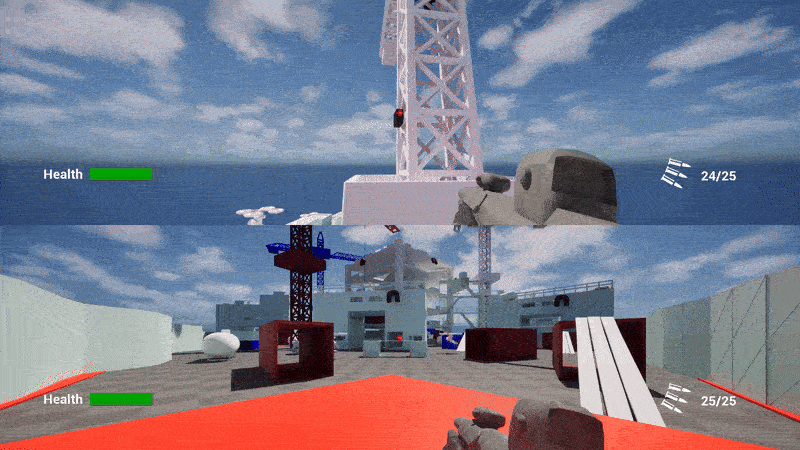
Balancing
As mentioned, one of the main challenges was ensuring that weapons felt distinct and meaningful while remaining fair in the context of fast-paced matches.
While spreadsheets help define base stats, scaling, and theoretical DPS, real gameplay revealed how additional factors, like player movement, engagement speed, positioning, weapon range, and how abilities interact with mobility, dramatically affects combat outcomes.


To address this, I relied heavily on hands-on testing and iterative design.
The sniper rifle appears strong on paper, but its low base damage and the challenge of landing precise shots keeps it balanced in practice. The shotgun delivers high burst potential at close range, but only if players can successfully close the distance.
Each weapon is tuned to support its intended role: the pistol encourages early resource farming, the shotgun dominates in close quarters, the assault rifle offers versatility across all ranges, and the sniper rewards precision and careful positioning.
This process reinforces that balance is not only about making numbers equal, but about ensuring every weapon feels fair, rewarding, and strategically meaningful in real matches, directly supporting the design goals outlined for the weapon system.

Audio Implementation & Mixing
PLANNING & COORDINATION
I created a sound list and sonic moodboard to define the tonal direction and functional needs of Site Zero’s audio. This established a clear foundation for collaboration with the sound designer and aligned expectations across the team.
I tracked the sounds in a shared Google Sheet created by the sound designer, then imported into Unreal Engine and implemented as Sound Cues.


DYNAMIC SOUND DESIGN
To add depth and reduce repetition, I implemented multi-variation Sound Cues for weapons, UI, and movement. Random pitch and volume variation made audio feel dynamic and responsive, while Reverb and Attenuation Settings ensures sounds behave naturally across different in-game environments.
I also created a dynamic footstep system that changes sounds based on surface material, enhancing immersion and player orientation in the industrial arena.
Assault Rifle & Resource
Dynamic Footsteps

COLLABORATION & ITERATION
I acted as a bridge between the sound designer and the team, collecting feedback, passing notes, and ensuring new or revised assets were correctly implemented. This iterative approach allowed us to refine and polish sounds efficiently, creating a cohesive audio experience that reinforced Site Zero’s competitive pacing and gritty atmosphere.



Project Management
MEETINGS & TASK MANAGEMENT
During the development of Site Zero, I naturally stepped into a project management role alongside my design responsibilities. I organized and ran daily standup meetings, managed Trello boards, proposed sprint priorities, and solved git-issues and conflicts. I also monitored progress across all roles and suggested new tasks from the sprint backlog when team members completed their work, keeping the project on track and focused on key goals.
COMMUNICATION
I maintained consistent communication with all team members, providing and receiving feedback, coordinating progress, and ensuring the group stayed aligned and productive. Regular check-ins and open discussion helped resolve issues quickly and kept the team informed on priorities.
PLAYTESTS & FEEDBACK
For each playtest, I collected feedback from the group, compiled survey results, and summarized observations to highlight key takeaways. I also recommended which points should be implemented and whether they belonged in the sprint or product backlog. This process ensured that playtest feedback informed core system iterations, level design adjustments, and balancing decisions effectively.
Reflection & Learnings
PROJECT MANAGEMENT AND LEADING DESIGN
Taking the lead on daily stand-ups and helping set project direction gave me invaluable experience in team coordination. I learned how to better encourage focus and momentum without over-managing, even though that was difficult. While workload balance was sometimes challenging, I developed stronger skills in leadership and communication that carried through the whole project.
INSPIRATION AND ANALYSIS OF OTHER GAMES
Looking back, I would have benefited from spending more structured time breaking down other FPS and 1v1-focused games. While I drew inspiration from Counter-Strike, Call of Duty, Apex Legends, and Quake, I mostly relied on memory rather than deeply analyzing their systems and design choices. A more thorough study early on could have helped refine our mechanics faster and saved iteration time later.
EARLY ALIGNMENT AND CLARITY WITH DOCUMENTATION
Creating the Two-Pager, NABC pitch, and GDD early gave the team a shared direction and helped keep us focused. In hindsight, I see the value of pushing even harder for structured, user-focused playtests with a wider variety of players. More feedback could have uncovered onboarding issues earlier and helped us address usability challenges sooner.
BUILDING THE TUTORIAL SYSTEM
The tutorial system succeeded in teaching the basics but could have been more adaptive and refined. A stronger design would have tied prompts to player actions and displayed learned controls persistently, creating a smoother and more reactive onboarding flow. This experience reinforced for me how critical accessibility and pacing are in player education.
FINAL THOUGHTS
Site Zero strengthened my ability to design systems, balance gameplay, and guide a team through development. It also confirmed that Game Design and Project Management are where I thrive most. The project may have had rough edges, but it gave me the kind of practical, hands-on growth I was looking for.


